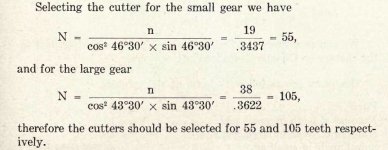crystalltiice
Aluminum
- Joined
- Jul 31, 2015
Hi,
I'm trying to cut a helical gear on the mill. Looks to be 12DP and 43 teeth from reverse engineering the pinion.
It seems there are three methods by which it can be done:
1. Involute gear cutter (bought or home made)
2. Fly cutter - think it might be tricky getting profile right.
3. Gear hob - most universal
All using the universal dividing head connected to the lead screw, head tilted to helix andgle.
The Gear hob looks best as one cutter can cut any number of teeth so no need to make 8 cutters. The questions is, can a Helical gear be made like this. Is the hob dimensions still the same, or does it need to look more like a thread/spiral profile? The ones I've seen for straight spur gears are parallel grooves with rack profile.
Never made a gear so this is all new to me, but willing to try!
I'm trying to cut a helical gear on the mill. Looks to be 12DP and 43 teeth from reverse engineering the pinion.
It seems there are three methods by which it can be done:
1. Involute gear cutter (bought or home made)
2. Fly cutter - think it might be tricky getting profile right.
3. Gear hob - most universal
All using the universal dividing head connected to the lead screw, head tilted to helix andgle.
The Gear hob looks best as one cutter can cut any number of teeth so no need to make 8 cutters. The questions is, can a Helical gear be made like this. Is the hob dimensions still the same, or does it need to look more like a thread/spiral profile? The ones I've seen for straight spur gears are parallel grooves with rack profile.
Never made a gear so this is all new to me, but willing to try!




 Guessed helix angle = wrong lead = tooth thickness wrong, etc.
Guessed helix angle = wrong lead = tooth thickness wrong, etc.
